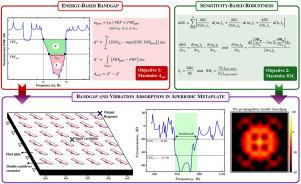Sensitivity and energy-based optimization of robust aperiodic metamaterials
IF 4.9
2区 工程技术
Q1 ACOUSTICS
引用次数: 0
Abstract
The design of acoustic metamaterials (AMMs) has predominantly relied on periodic configurations to create local resonance bandgaps for vibration control and noise mitigation. However, periodic structures are highly sensitive to manufacturing variability, leading to inconsistent bandgap performance and reduced reliability in practical applications. Aperiodic AMMs have recently emerged as alternatives, offering enhanced robustness and greater design flexibility. Despite their promise, optimizing such structures remains computationally expensive, especially when incorporating robustness considerations through Monte Carlo-based uncertainty quantification. This presents a fundamental challenge in the efficient and scalable design of robust aperiodic AMMs.
This work introduces a novel sensitivity-based measure of robustness, providing a computationally efficient alternative to Monte Carlo simulations. Using local sensitivity analysis, the proposed approach captures the impact of small parameter variations on bandgap robustness, significantly reducing computational costs without compromising accuracy. The robustness measure is integrated into a multi-objective optimization framework that simultaneously maximizes bandgap width and robustness using genetic algorithm. To further enhance the performance, a novel energy-based formulation is developed, which avoids explicitly imposing attenuation constraints. The vibrational energy of LRs is utilized to obtain wider bandgaps, allowing for higher design flexibility.
The methodology is demonstrated on a locally resonant AMM plate or metaplate featuring aperiodically arranged double-cantilever-like resonators. The results reveal that optimized aperiodic designs achieve significantly wider and more robust bandgaps compared to periodic counterparts, validating the effectiveness of the proposed framework. The bandgap performance of optimized aperiodic designs are validated through physical experiments on a metaplate. The resulting computational acceleration provides a step forward in the development of next-generation metamaterials tailored for real-world applications.

鲁棒非周期超材料的灵敏度和能量优化
声学超材料(amm)的设计主要依赖于周期性结构来产生局部共振带隙,以控制振动和降低噪声。然而,周期结构对制造变化非常敏感,导致带隙性能不一致,在实际应用中可靠性降低。近年来,非周期amm作为替代方案出现,提供了增强的稳健性和更大的设计灵活性。尽管前景看好,但优化此类结构的计算成本仍然很高,特别是在通过基于蒙特卡罗的不确定性量化纳入鲁棒性考虑时。这对设计高效、可扩展的鲁棒非周期自动调制器提出了根本性的挑战。这项工作引入了一种新的基于灵敏度的鲁棒性度量,为蒙特卡罗模拟提供了一种计算效率高的替代方案。利用局部灵敏度分析,该方法捕获了小参数变化对带隙鲁棒性的影响,在不影响精度的情况下显著降低了计算成本。鲁棒性度量被整合到一个多目标优化框架中,同时使用遗传算法最大化带隙宽度和鲁棒性。为了进一步提高性能,开发了一种新的基于能量的配方,避免了明确施加衰减约束。LRs的振动能量被用来获得更宽的带隙,允许更高的设计灵活性。该方法在具有非周期性排列双悬臂谐振器的局部谐振AMM板或metatplate上进行了演示。结果表明,与周期设计相比,优化的非周期设计实现了更宽、更稳健的带隙,验证了所提出框架的有效性。通过在元板上的物理实验验证了优化后的非周期设计的带隙性能。由此产生的计算加速为为现实世界的应用量身定制的下一代超材料的开发提供了一步。
本文章由计算机程序翻译,如有差异,请以英文原文为准。
求助全文
约1分钟内获得全文
求助全文
来源期刊

Journal of Sound and Vibration
工程技术-工程:机械
CiteScore
9.10
自引率
10.60%
发文量
551
审稿时长
69 days
期刊介绍:
The Journal of Sound and Vibration (JSV) is an independent journal devoted to the prompt publication of original papers, both theoretical and experimental, that provide new information on any aspect of sound or vibration. There is an emphasis on fundamental work that has potential for practical application.
JSV was founded and operates on the premise that the subject of sound and vibration requires a journal that publishes papers of a high technical standard across the various subdisciplines, thus facilitating awareness of techniques and discoveries in one area that may be applicable in others.
 求助内容:
求助内容: 应助结果提醒方式:
应助结果提醒方式:


